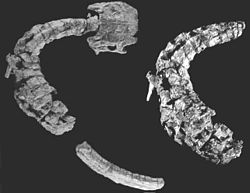| Gobiosuchidae Temporal range: Late Barremian - Late Campanian | |
|---|---|
 | |
| A specimen of Gobiosuchus encased in armor | |
| Scientific classification | |
| Kingdom: | Animalia |
| Phylum: | Chordata |
| Class: | Reptilia |
| Clade: | Archosauria |
| Clade: | Pseudosuchia |
| Clade: | Crocodylomorpha |
| Superfamily: | † Gobiosuchoidea |
| Family: | † Gobiosuchidae Osmólska, 1972 |
| Genera | |
Gobiosuchidae is a family of Cretaceous crocodyliforms known from Mongolia and Spain.


